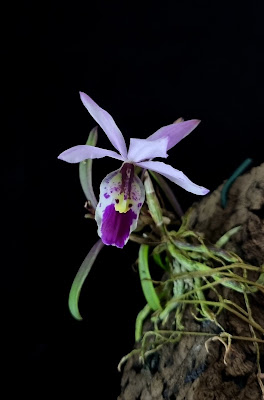Barkeria uniflora - Single-Flowered Barkeria flowers are attractive, resupinate, inodorous, 3.5-8.5 cm in diameter. Tepals are lilac-pink to white...
Barkeria uniflora also called as Single-Flowered Barkeria, Barkeria elegans, Epidendrum elegans, Pachyphyllum uniflorum is a species in the genus Barkeria. This species was described by Robert Louis Dressler and Federico Halbinger in 1977.
DESCRIPTION OF BARKERIA UNIFLORA - SINGLE-FLOWERED BARKERIA
Barkeria uniflora is native to Central and Southwestern Mexico. It is found growing on trees and shrubs along dry creekbeds in Mexico Central, Mexico Southwest at elevations of 670-1300 meters above sea level.
It is a miniature to large sized, warm to cool growing epiphyte which reaching 15-100 cm in height with a grayish-white, slightly thickened, fusiform with 4-9 internodes, 3-26 cm long pseudobulb. The leaves are 2 to 7, distichous, very fleshy, linear to lanceolate, acuminate to subacute, olive green lined with purple.
Single-Flowered Barkeria blooms in the fall to late spring from the terminal, erect, lax, pauciflorous panicle with 2-3 branches (rarely a raceme), from the new growth, on a peduncle covered by tubular bracts (scarious at anthesis), 5-50 cm long with 1-35 successive flowers with 3-8 open at any time. The flowers are attractive, resupinate, inodorous, 3.5-8.5 cm in diameter. Tepals are lilac-pink to white blushed with pink. Lip is white or very pale pink with a flabellate or transversally elliptic magenta blotch near the apex. Column is greenish-white, sometimes tinted with sufficient yellow or red to give it a salmon-colored pigmentation with purple spotting over the spine and two or three conspicuous “eyespots” at the apex. Anther cap is pale yellow.
BARKERIA UNIFLORA - SINGLE-FLOWERED BARKERIA CARE
Cultural information should only be used as a guide, and should be to be adapted to suit you. Your physical location; where you grow your plants, how much time you have to devote to their care, and many other factors, will need to be taken into account. Only then can you decide on the cultural methods that best suit you and your plants.
Light:
Barkeria uniflora needs a light level of 25000-40000 lux. A high level of light is required, but it should be dispersed or filtered. Probably, the plants will be in better condition if they are not exposed to the direct action of the southern sun. Strong air movement must be ensured all the time, especially if grown at high levels of light. If you have a cool humidifier, these plants will feel well placed near the outlet of cool, humid air.
Temperature:
The average temperature of the summer day is 24-27 ° C, the night 14-17 ° C, and the daily difference is 8-12 ° C. The average temperature of the winter day is 23-24 ° C, the night 12-15 ° C, and the daily difference is 9-11 ° C.
Humidity:
Single-Flowered Barkeria needs the average humidity of 70-80%. Too dry air has a negative effect on the development of the plant: its growth is inhibited, and the leaves begin to turn yellow and dry out. The higher temperature, the higher the humidity should be, and the higher the humidity, the more often and longer it is necessary to ventilate the room where the plants are contained, otherwise the probability of rotting and various kinds of fungal diseases. Good air movement is essential while the plants are in leaf and growing.
Substrate, growing media and repotting:
Barkeria uniflora are best grown on cork or tree fern rootstock, if it is possible to provide high humidity and watering in summer at least once a day. During hot, dry weather, it may be necessary to water several times a day.
The plants also grow very well mounted on the branches, run horizontally, in quite shady places. If you can not mount the plants, you can grow them in small, shallow pots or baskets with a very airy substrate. Although potted plants are not growing well, some plants of the Barkeria genus are able to adapt to growing in baskets, if we use a small amount of very thick substrate, such as pieces of tree fern.
Watering:
Single-Flowered Barkeria should be abundantly watered during active growth, at least once a day if the weather is hot and the level of light is high, but their roots must dry quickly. When new growths reach maturity in autumn, the amount of water should be reduced.
Fertilizer:
In the period of active growth, a balanced fertilizer should be used, in 1/4-1/2 doses of fertilizer for orchids. You can also use phosphate-enriched fertilizer from mid-summer to the end of autumn to improve flowering in the next season and strengthen new growth before winter.
Rest period:
Barkeria uniflora need a rest period when the leaves becoming deciduous. In winter and early spring, the plants should be considerably limited to the amount of water, but they can not remain completely dry for too long. Occasional morning misting, especially in sunny weather, will provide the plants with enough moisture and prevent excessive drying. Fertilization should be eliminated until new growths appear in the spring and normal watering begins.















COMMENTS